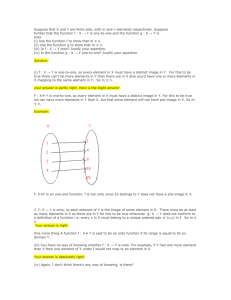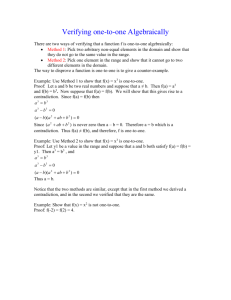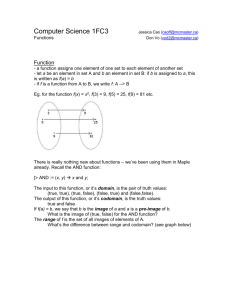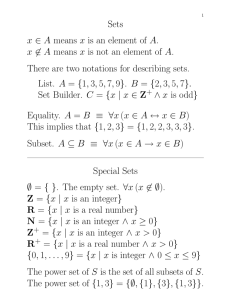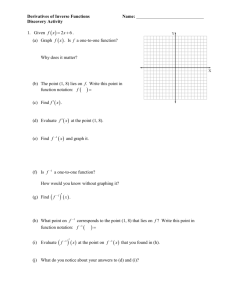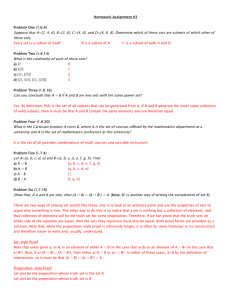Chapter 8 Functions and one-to-one
advertisement
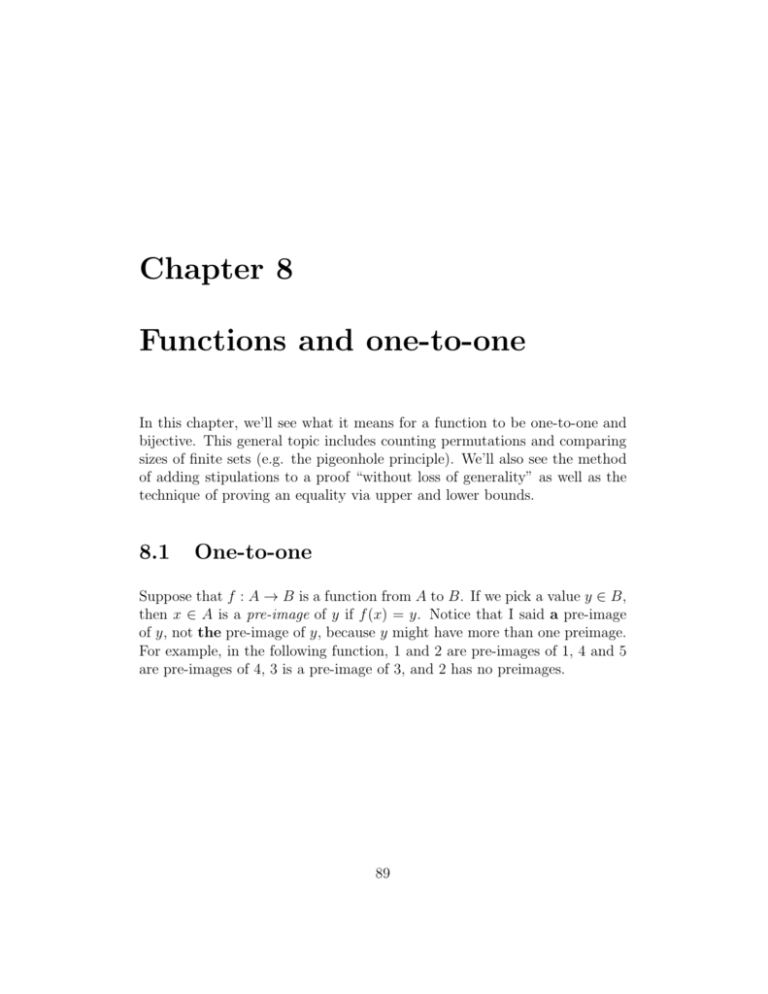
Chapter 8
Functions and one-to-one
In this chapter, we’ll see what it means for a function to be one-to-one and
bijective. This general topic includes counting permutations and comparing
sizes of finite sets (e.g. the pigeonhole principle). We’ll also see the method
of adding stipulations to a proof “without loss of generality” as well as the
technique of proving an equality via upper and lower bounds.
8.1
One-to-one
Suppose that f : A → B is a function from A to B. If we pick a value y ∈ B,
then x ∈ A is a pre-image of y if f (x) = y. Notice that I said a pre-image
of y, not the pre-image of y, because y might have more than one preimage.
For example, in the following function, 1 and 2 are pre-images of 1, 4 and 5
are pre-images of 4, 3 is a pre-image of 3, and 2 has no preimages.
89
90
CHAPTER 8. FUNCTIONS AND ONE-TO-ONE
1
3
2
3
4
2
1
4
5
A function is one-to-one if it never assigns two input values to the same
output value. Or, said another way, no output value has more than one preimage. So the above function isn’t one-to-one, because (for example) 4 has
more than one pre-image. If we define g : Z → Z such that g(x) = 2x. Then
g is one-to-one.
As with onto, whether a function is one-to-one frequently depends on its
type signature. For example, the absolute value function |x| is not one-toone as a function from the reals to the reals. However, it is one-to-one as a
function from the natural numbers to the natural numbers.
One formal definition of one-to-one is:
∀x, y ∈ A, x 6= y → f (x) 6= f (y)
For most proofs, it’s more convenient to use the contrapositive:
∀x, y ∈ A, f (x) = f (y) → x = y
When reading this definition, notice that when you set up two variables
x and y, they don’t have to have different (math jargon: “distinct”) values.
In normal English, if you give different names to two objects, the listener is
expected to understand that they are different. By contrast, mathematicians
always mean you to understand that they might be different but there’s also
the possibility that they might be the same object.
CHAPTER 8. FUNCTIONS AND ONE-TO-ONE
8.2
91
Bijections
If a function f is both one-to-one and onto, then each output value has
exactly one pre-image. So we can invert f , to get an inverse function f −1 . A
function that is both one-to-one and onto is called bijective or a bijection. If
f maps from A to B, then f −1 maps from B to A.
Suppose that A and B are finite sets. Constructing an onto function
from A to B is only possible when A has at least as many elements as B.
Constructing a one-to-one function from A to B requires that B have at least
as many values as A. So if there is a bijection between A and B, then the two
sets must contain the same number of elements. As we’ll see later, bijections
are also used to define what it means for two infinite sets to be the “same
size.”
8.3
Pigeonhole Principle
Suppose that A contains more elements than B. Then it’s impossible to
construct a bijection from A to B, because two elements of A must be mapped
to the same element of B. If we rephrase this in terms of putting labels on
objects, we get the following Pigeonhole Principle:
Pigeonhole principle: Suppose you have n objects and assign
k labels to these objects. If n > k, then two objects must get the
same label.
For example, if you have 8 playing cards and the cards come in five colors,
then at least two of the cards share the same color. Or, if you have a 30character string containing lowercase letters, it must contain some duplicate
letters, because 26 is smaller than 30.
The pigeonhole principle (like many superheros) has a dual identity.
When you’re told to apply it to some specific objects and labels, it’s obvious how to do so. However, it is often pulled out of nowhere as a clever
trick in proofs, where you would have never suspected that it might be useful.
Such proofs are easy to read, but sometimes hard to come up with.
CHAPTER 8. FUNCTIONS AND ONE-TO-ONE
92
For example, here’s a fact that we can prove with a less obvious application of the pigeonhole principle.
Claim 34 Suppose that T is an equilateral triangle with sides of length 2
units We can place a maximum of four points in the triangle such that every
pair of points are more than 1 unit apart.
To show that 4 is the maximum number of points we can place with the
required separations, we need to show that it’s possible to place 4 points,
but it is not possible to place 5 points. It’s easiest to tackle these two subproblems separately, using different techniques.
Proof: To show that the maximum is at least four, notice that
we can place three points at the corners of the triangle and one
point in the center. The points at the corners are two units apart.
To see that the point in the center is more than one unit from
any corner, notice that the center, the corner, and the midpoint
of the side form a right triangle.
1
The hypotenuse of this triangle connects the center point to the
corner point. Since one leg of the triangle has length 1, the hypotenuse must have length greater than 1.
To show that the maximum number of points cannot be greater
than four, divide up the triangle into four smaller equilateral triangles as follows:
CHAPTER 8. FUNCTIONS AND ONE-TO-ONE
93
Suppose we tried to place five or more points into the big triangle. Since there are only four small triangles, by the pigeonhole
principle, some small triangle would have to contain at least two
points. But since the small triangle has side length only 1, these
points can’t be separated by more than one unit.
The tricky part of this proof isn’t the actual use of the pigeonhole principle. Rather, it’s the setup steps, e.g. dividing up the triangle, that got us
to the point where the pigeonhole principle could be applied. This is typical
of harder pigeonhole principle proofs.
8.4
Permutations
Now, suppose that |A| = n = |B|. We can construct a number of one-to-one
functions from A to B. How many? Suppose that A = {x1 , x2 , . . . , xn }.
We have n ways to choose the output value for x1 . But that choice uses up
one output value, so we have only n − 1 choices for the output value of x2 .
Continuing this pattern, we have n(n − 1)(n − 2) . . . 2 · 1 (n! for short) ways
to construct our function.
Similarly, suppose we have a group of n dragon figurines that we’d like to
arrange on the mantlepiece. We need to construct a map from positions on
the mantlepiece to dragons. There are n! ways to do this. An arrangement
of n objects in order is called a permutation of the n objects.
More frequently, we need to select an ordered list of k objects from a
larger set of n objects. For example, we have 30 dragon figurines but space
for only 10 on our mantlepiece. Then we have 30 choices for the first figurine,
CHAPTER 8. FUNCTIONS AND ONE-TO-ONE
94
29 for the second, and so forth down to 21 choices for the last one. Thus we
have 30 · 29 · . . . 21 ways to decorate the mantlepiece.
In general, an ordered choice of k objects from a set of n objects is known
n!
as a k-permutation of the n objects. There are n(n−1) . . . (n−k +1) = (n−k)!
different k-permutations of n objects. This number is called P (n, k). P (n, k)
is also the number of one-to-one functions from a set of k objects to a set of
n objects.
8.5
Further applications of permutations
Many real-world counting problems can be solved with the permutations formulas, but some problems require a bit of adaptation. For example, suppose
that 7 adults and 3 kids need to get in line at the airport. Also suppose that
we can’t put two children next to each other, because they will fight.
The trick for this problem is to place the 7 adults in line, with gaps
between them. Each gap might be left empty or filled with one kid. There
are 8 gaps, into which we have to put the 3 kids. So, we have 7! ways to
assign adults to positions. Then we have 8 gaps in which we can put kid A,
7 for kid B, and 6 for kid C. That is 7! · 8 · 7 · 6 ways to line them all up.
Now, let’s suppose that we have a set of 7 scrabble tiles and we would
like to figure out how many different letter strings we can make out of them.
We could almost use the permutations formula, except that some of the
tiles might contain the same letter. For example, suppose that the tiles are:
C, O, L, L, E, G, E.
First, let’s smear some dirt on the duplicate tiles, so we can tell the
two copies apart: C, O, L1, L2 , E1 , G, E2 . Then we would calculate 7! permutations of this list. However, in terms of our original problem, this is
double-counting some possibilities, because we don’t care about the difference between duplicates like L1 and L2 . So we need to divide out by the
number of ways we can permute the duplicates. In this case, we have 2! ways
to permute the l’s and 2! ways to permute the e’s. So the true number of
7!
orderings of L is 2!2!
.
Similarly, the number of reorderings of J = (a, p, p, l, e, t, r, e, e, s) is
10!
.
2!3!
CHAPTER 8. FUNCTIONS AND ONE-TO-ONE
95
In general, suppose we have n objects, where n1 are of type 1, n2 are of
type 2, and so forth through nk are of type k. Then the number of ways to
order our list of objects is n1 !n2n!!...nk ! .
8.6
Proving that a function is one-to-one
Now, let’s move on to examples of how to prove that a specific function is
one-to-one.
Claim 35 Let f : Z → Z be defined by f (x) = 3x + 7. f is one-to-one.
Let’s prove this using our definition of one-to-one.
Proof: We need to show that for every integers x and y, f (x) =
f (y) → x = y.
So, let x and y be integers and suppose that f (x) = f (y). We
need to show that x = y.
We know that f (x) = f (y). So, substituting in our formula for f ,
3x + 7 = 3y + 7. So 3x = 3y and therefore x = y, by high school
algebra. This is what we needed to show.
When we pick x and y at the start of the proof, notice that we haven’t
specified whether they are the same number or not. Mathematical convention
leaves this vague, unlike normal English where the same statement would
strongly suggest that they were different.
8.7
Composition and one-to-one
Like onto, one-to-one works well with function composition. Specifically:
Claim 36 For any sets A, B, and C and for any functions f : A → B and
g : B → C, if f and g are one-to-one, then g ◦ f is also one-to-one.
CHAPTER 8. FUNCTIONS AND ONE-TO-ONE
96
We can prove this with a direct proof, by being systematic about using our
definitions and standard proof outlines. First, let’s pick some representative
objects of the right types and assume everything in our hypothesis.
Proof: Let A, B, and C be sets. Let f : A → B and g : B → C
be functions. Suppose that f and g are one-to-one.
We need to show that g ◦ f is one-to-one.
To show that g ◦ f is one-to-one, we need to pick two elements x and
y in its domain, assume that their output values are equal, and then show
that x and y must themselves be equal. Let’s splice this into our draft proof.
Remember that the domain of g ◦ f is A and its co-domain is C.
Proof: Let A, B, and C be sets. Let f : A → B and g : B → C
be functions. Suppose that f and g are one-to-one.
We need to show that g ◦ f is one-to-one. So, choose x and y in
A and suppose that (g ◦ f )(x) = (g ◦ f )(y)
We need to show that x = y.
Now, we need to apply the definition of function composition and the fact
that f and g are each one-to-one:
Proof: Let A, B, and C be sets. Let f : A → B and g : B → C
be functions. Suppose that f and g are one-to-one.
We need to show that g ◦ f is one-to-one. So, choose x and y in
A and suppose that (g ◦ f )(x) = (g ◦ f )(y)
Using the definition of function composition, we can rewrite this
as g(f (x)) = g(f (y)). Combining this with the fact that g is
one-to-one, we find that f (x) = f (y). But, since f is one-to-one,
this implies that x = y, which is what we needed to show.
CHAPTER 8. FUNCTIONS AND ONE-TO-ONE
8.8
97
Strictly increasing functions are one-toone
Now, let’s do a slightly trickier proof. First, a definition. Suppose that A
and B are sets of real numbers (e.g. the reals, the rationals, the integers).
A function f : A → B is increasing if, for every x and y in A, x ≤ y implies
that f (x) ≤ f (y). f is called strictly increasing if, for every x and y in A,
x < y implies that f (x) < f (y).1
Claim 37 For any sets of real numbers A and B, if f is any strictly increasing function from A to B, then f is one-to-one.
A similar fact applies to strictly decreasing functions.
To prove this, we will restate one-to-one using the alternative, contrapositive version of its definition.
∀x, y ∈ A, x 6= y → f (x) 6= f (y)
Normally, this wouldn’t be a helpful move. The hypothesis involves a
negative fact, whereas the other version of the definition has a positive hypothesis, normally a better place to start. But this is an atypical example
and, in this case, the negative information turns out to be a good starting
point.
Proof: Let A and B be sets of numbers and let f : A → B be a
strictly increasing function. Let x and y be distinct elements of
A. We need to show that f (x) 6= f (y).
Since x 6= y, there’s two possibilities.
Case 1: x < y. Since f is strictly increasing, this implies that
f (x) < f (y). So f (x) 6= f (y)
Case 2: y < x. Since f is strictly increasing, this implies that
f (y) < f (x). So f (x) 6= f (y).
1
In math, “strictly” is often used to exclude the possibility of equality.
CHAPTER 8. FUNCTIONS AND ONE-TO-ONE
98
In either case, we have that f (x) 6= f (y), which is what we needed
to show.
The phrase “distinct elements of A” is math jargon for x 6= y.
When we got partway into the proof, we had the fact x 6= y which isn’t
easy to work with. But the trichotomy axiom for real number states that for
any x and y, we have exactly three possibilities: x = y, x < y, or y < x. The
constraint that x 6= y eliminates one of these possibilities.
8.9
Making this proof more succinct
In this example, the proofs for the two cases are very, very similar. So we can
fold the two cases together. Here’s one approach, which I don’t recommend
doing in the early part of this course but which will serve you well later on:
Proof: Let A and B be sets of numbers and let f : A → B be a
strictly increasing function. Let x and y be distinct elements of
A. We need to show that f (x) 6= f (y).
Since x 6= y, there’s two possibilities.
Case 1: x < y. Since f is strictly increasing, this implies that
f (x) < f (y). So f (x) 6= f (y)
Case 2: y < x. Similar to case 1.
In either case, we have that f (x) 6= f (y), which is what we needed
to show.
This method only works if you, and your reader, both agree that it’s
obvious that the two cases are very similar and the proof will really be similar.
Dangerous assumption right now. And we’ve only saved a small amount of
writing, which isn’t worth the risk of losing points if the grader doesn’t think
it was obvious.
But this simplification can be very useful in more complicated situations
where you have may have lots of cases, the proof for each case is long, and
the proofs for different cases really are very similar.
CHAPTER 8. FUNCTIONS AND ONE-TO-ONE
99
Here’s another way to simplify our proof:
Proof: Let A and B be sets of numbers and let f : A → B be a
strictly increasing function. Let x and y be distinct elements of
A. We need to show that f (x) 6= f (y).
We know that x 6= y, so either x < y or y < x. Without loss of
generality, assume that x < y.
Since f is strictly increasing, x < y implies that f (x) < f (y). So
f (x) 6= f (y), which is what we needed to show.
The phrase “without loss of generality” means that we are adding an
additional assumption to our proof but we claim it isn’t really adding any
more information. In this case, s and t are both arbitrary indices introduced
at the same time. It doesn’t really matter which of them is called s and which
is called t. So if we happen to have chosen our names in an inconvenient order,
we could simply swap the two names.
Simplifying a problem “without loss of generality” is a powerful but potentially dangerous proof technique. You’ll probably probably want to see a
few times before you use it yourself. It’s actually used fairly often to simplify
proofs, so it has an abbreviation: WOLOG or WLOG.
8.10
Variation in terminology
The term “injective” is a synonym for one-to-one and one-to-one correspondence is a synonym for bijective. The phrase “by symmetry” is often used
in place of “without loss of generality.”
